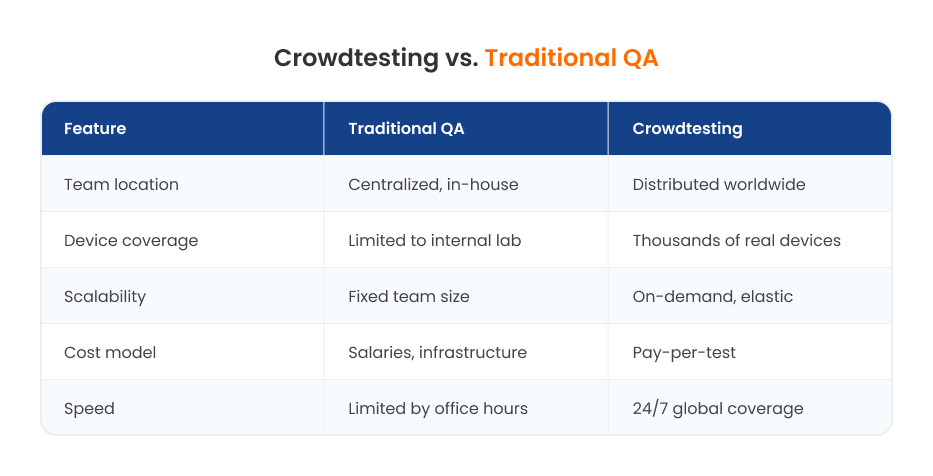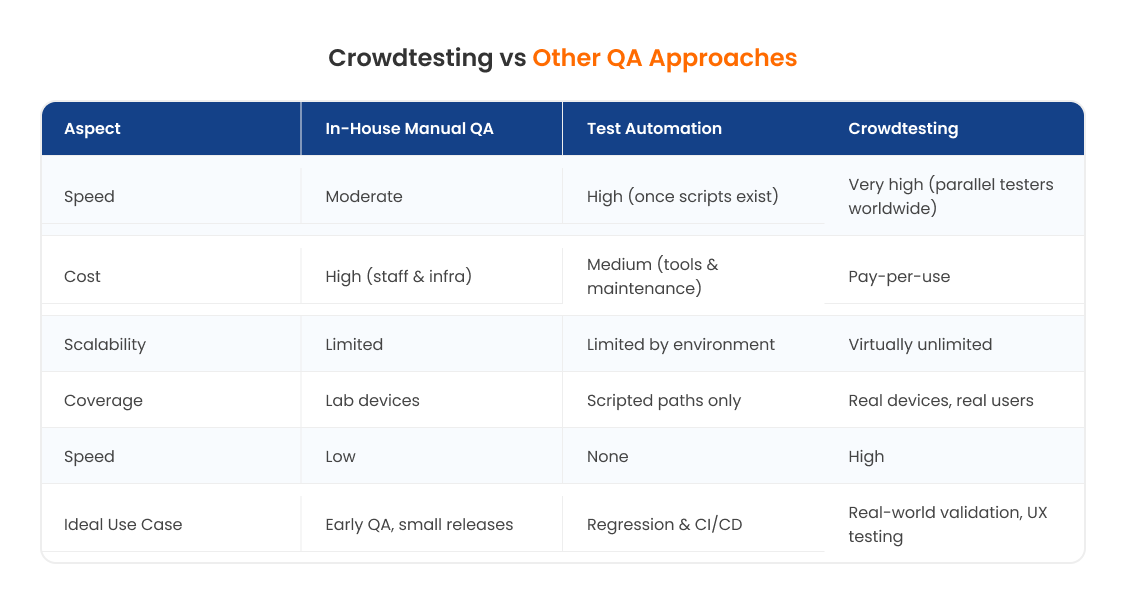The Comprehensive Crowdtesting Guide for Software Success 2026

Introduction
According to MarketsandMarkets, the global crowdsourced testing market is projected to reach $2.5 billion by 2028, growing at a CAGR of over 10%. Behind this growth lies a simple truth: today’s software products must perform flawlessly across an overwhelming diversity of devices, networks, and user contexts.
From device fragmentation and shorter release cycles to increasing user diversity, QA teams are under constant pressure to deliver faster without sacrificing quality. Traditional, centralized QA processes can no longer keep pace with agile development, continuous deployment, and the expectations of global users.
Enter crowdtesting or crowdsourced testing, the scalable, real-world solution that leverages distributed communities of professional testers and real users to validate software under true-to-life conditions.
Ubertesters, a global crowdtesting company with thousands of vetted testers across 150+ countries, is enabling businesses to achieve flawless quality and user satisfaction faster and more efficiently than ever before.
What Is Crowdtesting?
Crowdtesting (also known as crowdsourced testing) is a modern QA model that involves using a distributed network of real users and professional testers to evaluate software quality, usability, and functionality under real-world conditions.
Instead of relying solely on internal QA teams, businesses partner with managed crowdtesting platforms that coordinate diverse testers around the world. These testers use their own devices, networks, and environments to perform tests and provide detailed feedback, ensuring results reflect real user experiences.
How It Works
- Tester selection: Ubertesters select testers, according to the client’s requirements, based on demographic and technical criteria such as device type, OS version, location, language, and user behavior to mirror the product’s target audience.
- Task distribution: Test project managers assign tasks or test cases (e.g., complete a checkout flow, test login, or validate payment success).
- Validation and feedback: Testers report bugs with screenshots, logs, or videos; QA leads verify and triage results to ensure accuracy.
In short, crowdtesting extends the reach of QA beyond the lab. It transforms testing from a controlled simulation into a real-user validation process, uncovering issues that only surface in authentic usage environments.

The Evolution of QA: From In-House to the Global Crowd
Software testing has evolved dramatically over the past two decades.
Early 2000s: Beta Testing and Community QA
In the early days, companies relied on closed beta testing, small groups of enthusiasts who provided feedback before launch. It was informal, unstructured, and hard to manage. As digital ecosystems expanded, so did the need for more organized, repeatable, and scalable testing processes.
2010s: Agile and DevOps Acceleration
The rise of Agile and DevOps methodologies reshaped software delivery. Continuous integration (CI) and continuous deployment (CD) meant faster releases, sometimes daily or hourly. QA needed to match this pace.
According to Gartner, by 2026, nearly 70% of software companies will use external testing communities to supplement internal QA teams. This shift reflects a broader transformation from testing as a late-stage gatekeeper to testing as a continuous process.
2020s: The Era of Managed Crowdtesting
As digital products became global, companies needed real-world validation across devices, networks, and geographies. Managed crowdtesting services emerged as the answer, combining structured QA methodologies with the power of global user communities.
For companies embracing continuous delivery and product-led growth, crowdtesting is now essential. It ensures software remains functional, localized, and user-friendly no matter where or how it’s used.
Benefits of Crowdtesting
The advantages of crowdsourced testing extend far beyond cost savings. It provides speed, diversity, and quality at scale all aligned with modern development cycles.
1. Real-World Coverage
Crowdtesting ensures validation under authentic conditions across thousands of devices, locations, networks, and languages. Whether testing on iOS 17 in London or Android 13 in São Paulo, companies get visibility into how users truly experience their app.
2. Speed and Scalability
Because testers work in multiple time zones, results often arrive within 24 hours. Test cycles that might take weeks in-house can now be completed overnight, a perfect fit for agile sprints and CI/CD pipelines.
3. Cost Efficiency
Instead of maintaining large internal QA teams and device labs, businesses pay only for executed tests. The pay-per-test model makes it easy to scale up or down based on project needs, reducing overhead and maximizing ROI.
4. Objective Feedback
Crowdtesters bring an unbiased, real-user perspective. They identify usability issues developers might overlook, such as confusing navigation or unclear copy, giving teams actionable insights into user experience.
5. Cross-Device and Cross-Platform Confidence
Modern users expect seamless performance on every screen. Software crowd testing ensures that apps function consistently across different OS versions, browsers, and screen sizes, delivering cross-platform stability.
6. Continuous Improvement
Crowdtesting fits naturally into continuous integration pipelines. Each release can be validated by real users before going live, creating a loop of rapid detection and resolution.
Stats That Speak
Companies using crowdtesting see 30–50% higher bug detection compared to in-house QA (Capgemini World Quality Report 2024).
IDC (2025) found that managed crowdtesting can reduce time-to-market by up to 40%.
85% of enterprises that adopted crowdtesting reported improved user satisfaction scores within three release cycles.
Together, these benefits position crowdtesting not as a supplement but as a core pillar of modern QA strategy.
How Crowdtesting Works: From Setup to Reporting
A successful crowdtesting process follows a clear, structured path that balances real-world testing with professional QA management.
Step 1: Define Scope and Test Cases
The project team sets goals, target devices, OS versions, user segments, and test scenarios. This ensures the test plan reflects the product’s actual use cases.
Step 2: Select and Brief Testers
Crowdtesting platforms match projects with testers based on demographics, devices, and language proficiency. A detailed briefing defines expectations, acceptance criteria, and reporting standards.
Step 3: Test Execution and Reporting
Testers execute predefined tasks such as signing up, making a payment, or changing settings and log defects, screenshots, and videos via the platform. This provides transparency and reproducibility.
Step 4: Validation and Triage
Experienced QA project managers review reports, eliminate duplicates, and validate real defects. This step guarantees data accuracy and ensures that development teams focus only on verified issues.
Step 5: Deliver Actionable Reports
Results are presented in real-time dashboards with severity levels, device data, and Jira or TestRail integrations for smooth collaboration.
Step 6: Fix Issues, Re-Test, Repeat
Crowdtesting supports iterative cycles. Once fixes are implemented, a re-test validates resolutions, accelerating continuous improvement.
This structured process ensures testing remains both realistic and reliable, combining human diversity with professional QA oversight.
Types of Crowdtesting Services

Different goals demand different testing approaches. Managed crowd testing services typically include a broad range of test types from functional validation to user experience and compliance.
1. Functional Testing
Validates that each feature works as intended across devices, OS versions, and user accounts. Testers follow predefined scenarios to ensure reliability and correctness.
2. Exploratory Testing
Encourages testers to use their creativity and experience to find unexpected bugs beyond scripted cases. Ideal for uncovering hidden edge cases and usability gaps.
3. User Experience (UX) Testing
Real users provide qualitative feedback on design, navigation, and satisfaction. Companies gain insights into how intuitive and enjoyable the product feels.
4. Localization Testing
Checks translations, currencies, date formats, and cultural relevance. Localization crowdtesting ensures global users experience the product naturally in their native context.
5. Payment Testing
One of the most critical QA types is verifying checkout flows, payment gateways, and transaction success under various cards, currencies, and networks.
6. Usability Testing
Analyzes interaction patterns and identifies friction points that may impact retention or conversion rates.
7. Mystery Shopping Testing
Testers simulate real customer journeys from browsing to support, evaluating service quality and response consistency.
8. Regression Testing
After updates, testers verify that existing functionality remains intact. Crucial for maintaining software stability across iterations.
9. Accessibility Testing
Evaluates compliance with accessibility standards (WCAG 2.2, ADA), ensuring usability for people with disabilities.
10. Location & Network Testing
Assesses performance under different GPS coordinates, Wi-Fi or mobile networks essential for travel, IoT, and navigation apps.
11. Interrupt Testing
Simulates incoming calls, low battery, or background app interruptions to test system resilience.
By combining these types, organizations can achieve 360-degree software validation through one unified, managed process.
Key Use Cases by Industry

Crowdtesting adapts seamlessly across verticals wherever digital products meet diverse end users.
FinTech
- Validating payment security, KYC flows, and currency conversions.
- Ensuring mobile banking apps perform across devices and regions.
- Detecting issues with two-factor authentication or regional payment gateways.
E-Commerce
- Testing checkout flows, discount codes, and cart recovery processes.
- Ensuring responsiveness and localization across languages and currencies.
- Data point: Over 65% of eCommerce businesses discover UX or localization bugs only after release (Adobe Digital Trends 2025).
Gaming
- Identifying platform-specific bugs on PC, console, and mobile.
- Testing performance under real network latency and multiplayer conditions.
Travel & Mobility
- Validating GPS accuracy, map rendering, and in-app booking.
- Simulating traveler experiences across time zones and networks.
IoT & Hardware
- Ensuring device interoperability and firmware compatibility.
- Testing app-to-device communication under real environmental conditions.
Media & Entertainment
- Evaluating video playback, subtitle synchronization, and streaming quality.
- Testing across smart TVs, set-top boxes, and mobile apps.
Each of these industries benefits from the real-user coverage and speed that only global crowdtesting can deliver without the logistical burden of building internal device farms or regional QA teams.
Crowdtesting vs Other QA Approaches
Crowdtesting doesn’t replace other QA models; it complements them. Below is a side-by-side comparison of manual QA, automation, and crowdsourced testing.
Synergy, Not Competition
A hybrid QA model combining automation for repetitive checks and crowdtesting for real-world validation and edge cases offers the best of both worlds. Automation ensures baseline stability; the crowd ensures human insight and environmental diversity.
In agile environments, this synergy enables continuous quality assurance, where every sprint delivers not only new features but also verified user experiences.
The Future of Crowdtesting in 2026 and Beyond
As software ecosystems evolve, so does crowdtesting. The next phase is powered by AI, automation, and predictive analytics.
AI-Assisted Test Management
AI will streamline tester assignment, defect categorization, and test coverage prediction, allowing faster matching between product requirements and the most qualified testers.
Predictive Quality Analytics
Advanced analytics will identify high-risk areas before release, predicting where bugs are most likely to appear based on historical data.
Expansion of Accessibility & Ethical Testing
Companies will increasingly rely on crowdsourced accessibility testing to ensure inclusivity, while ethical testing will address algorithmic bias and privacy considerations.
According to Gartner, by 2027, 80% of DevOps pipelines will include external crowdtesting to accelerate QA cycles.
In short, the future of software crowd testing will blend human intuition, machine precision, and real-world data, ensuring faster, smarter, and more ethical digital quality assurance.
Conclusion
As digital experiences become the backbone of every business, quality assurance is no longer optional; it’s a competitive advantage.
Crowdtesting stands out as the most scalable, diverse, and realistic way to ensure software works perfectly for every user, everywhere. By integrating it early in the SDLC, organizations can catch issues before they reach customers, shorten release cycles, and improve overall satisfaction.
Whether you’re a startup scaling your first app or an enterprise releasing global updates, partnering with a managed crowdtesting platform like Ubertesters brings you the real-world validation your users deserve.
Ready to achieve flawless quality with real users worldwide?
Learn how Ubertesters can make your next release a success.


